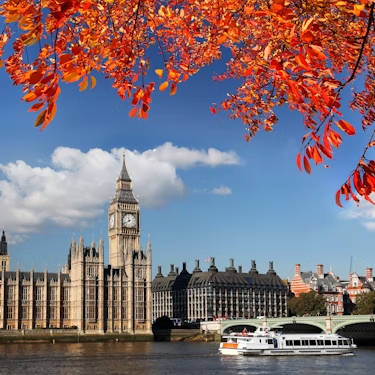More about: Things to do in London in 7 days
Spending a full week in London can be considered a real luxury for travel lovers. In seven days you can visit the main attractions of London and discover some of its most hidden secrets.
Such a stay will allow you to visit historical monuments such as Buckingham Palace, the Tower of London or Big Ben, as well as visit some of its many museums. In addition, you will be able to get to know the British capital without haste and enjoy it in all its essence.
Day 1: walk from Marble Arch to Big Ben

Although you will have to get up early to make the most of the day, this first day will bring you great satisfaction. During it you will be able to see one of the iconic events of the capital, the Changing of the Guard, and you will also visit one of the most important museums in the world.
Marble Arch
This tour could well be done in one of the tourist buses in London, but there is no problem if you prefer to make the most of it and do it walking.
The start of it is the Marble Arch, a triumphal arch that was once located at the entrance of Buckingham Palace and today is one of the best known images of the city.
Buckingham Palace and the Changing of the Guard
During the tour to Buckingham Palace I advise you to stop for a moment to contemplate the Wellington Arch, built to celebrate the English victory over Napoleon.
After walking part of the Diana Memorial Walk you finally arrive at the palace, the main residence of the British kings. If you have risen early and are there around 10:30 - 11:00, you can witness the famous Changing of the Guard at Buckingham Palace.
Enter Westminster Abbey
To admire the culture and history present in London there is nothing better than entering Westminster Abbey. Calculate that the visit will take you about two hours and keep in mind that you can access with the London Pass tourist card or by purchasing tickets for Westminster Abbey in advance, as there are usually quite long queues.
Westminster Abbey is the place where the coronations and funerals of the kings of the country are still celebrated. Inside are buried illustrious figures such as Isaac Newton, Charles Dickens and Charles Darwin, as well as the kings of England.
Trafalgar Square and National Gallery
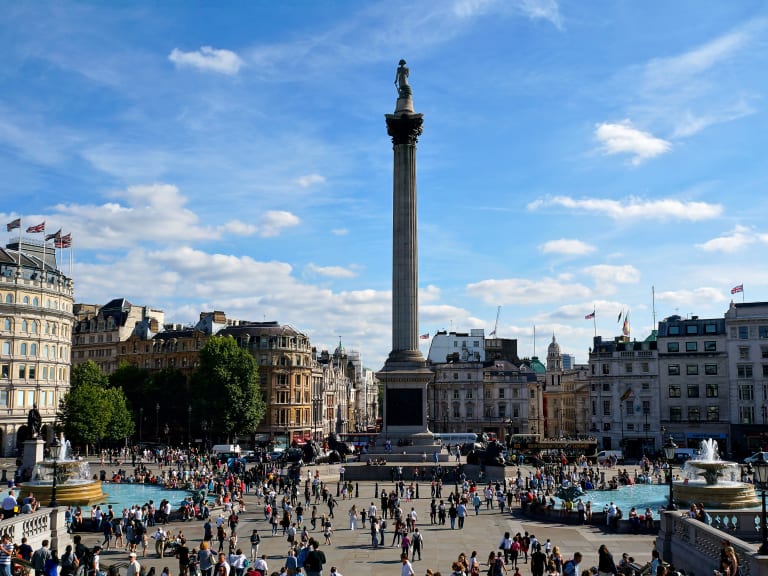
From Westminster you continue your tour to London's most famous square, Trafalgar Square, where you will be greeted by the statue of Admiral Nelson and his four lions. Here you will be greeted by the statue of Admiral Nelson and his four lions.
In addition to strolling through it, the square houses the National Gallery, a museum that is a must for art lovers.
Free admission, the gallery contains a large collection of paintings by European artists from the thirteenth century to the twentieth century. Among others, you can see works by Rembrandt, Titian, Velazquez and Van Gogh, just to name a few.
On the way to Big Ben via Downing Street
When you have finished admiring the works of these painters you should look for the entrance to Whitehall Street, which leads to Parliament Square.
Along the way you can see a surviving section of a palace that burned in 1698 and retains a ceiling painted by Rubens.
Before reaching Parliament Square you will pass through the famous Downing Street, the street where is the official residence of the British Prime Minister, specifically at number 10.
Once in the square you will find several statues representing various famous people from around the world, such as Winston Churchill, Abraham Lincoln and Nelson Mandela among others.
However, the main attraction of the square is the Palace of Westminster, also known as the Houses of Parliament. It is here where the tower known as Big Ben is located, although, in reality, that name only refers to the bell placed there.
London by night
It is very likely that the night is upon you. My advice is to join one of the London night tours that go around the capital and that will allow you to see **London'**s monuments from a different perspective.
Day 2: From the British Museum to Saint Paul's

Like the previous day, this second day should start early if you want to make the most of your time. The itinerary includes some of the most important museums in the city and the most visited religious building.
Guided tour
To start this day the best thing to do is to hire one of the many guided tours in London. This will not only help you to discover some attractions that you have not yet seen, but it will also help you to understand what you have visited so far and to have information about what you will visit in the following days.
The offer of these tours is really impressive. You can choose between walking, cycling, bus or boat tours with the theme of your choice.
Soak up history at the British Museum
When the tour is over head to one of London's finest museums, the British Museum, which is free to enter.
Please note that the visit will never take less than two hours, although it will take several days to see it in its entirety.
Its collection includes more than seven million objects from all over the world, including the famous Rosetta Stone.
To make the most of your time, it is best to study in advance what you want to see to go directly to the corresponding rooms. It is also highly recommended to pick up the audio guide offered to be better informed about what you are seeing.
More history at St. Paul's Cathedral
While the exterior view of St. Paul's Cathedral is already impressive given its size, second only to St. Peter's Basilica in Rome, its interior will not disappoint anyone.
As soon as you enter you get the impression of being in a unique place full of history. It is undoubtedly one of the best monuments in London, thanks, among other things, to its wonderful decoration.
During your visit you should pay special attention to the frescoes that decorate its ceilings, as well as climb the dome and enter the crypt.
The wonderful views from The Shard
The last visit of the day is after crossing Tower Bridge towards City Hall. It is to enjoy the views from The Shard, a modern skyscraper where you can enjoy an impressive viewpoint.
There is also a restaurant in The Shard where you can dine. If you prefer somewhere else, the surrounding area offers a good variety, as you can see in this article on where to eat near The Shard.
Day 3: from Camden Market to London Soho
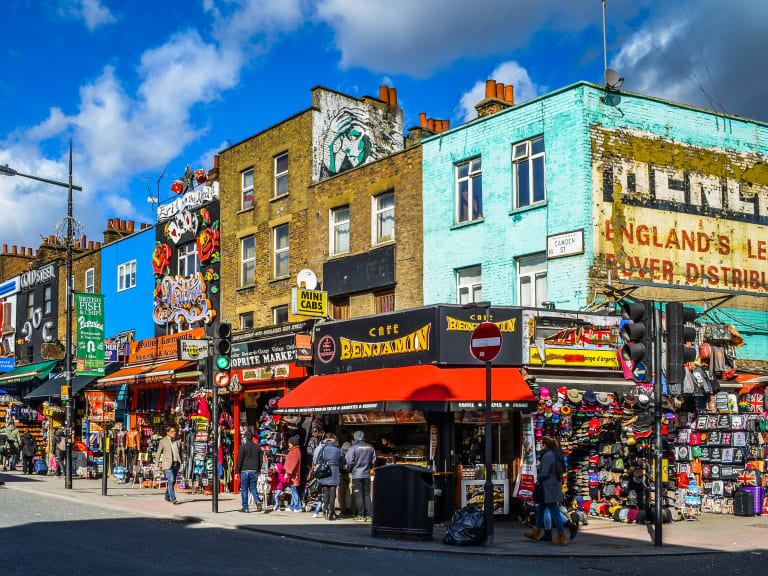
To celebrate the third day of the trip I have prepared a route that takes you from one of the most important and picturesque markets of the city to its busiest streets. Keep in mind that, almost certainly, you will have to go somewhere by tube, so here is a little guide on how to use the London Underground.
Camden Town
The day begins with a visit to Camden Town, one of the most interesting neighborhoods in London. Although it is usually very crowded by the large influx of tourists, it still retains some of its old essence, especially in the market that is held there.
In addition to the various stalls that you will find, try to also look at the facades of the buildings. As a special place, try to visit the stables.
How much time you want to spend here really depends on your interest. In fact, many people even take the opportunity to eat at the market, but keep in mind that the more time you spend here, the less time you will have left to see other places.
Tate Modern
If you have time left after seeing the market, the next stop is the Tate Modern, one of the most visited modern art museums in the world.
Really, this visit to the Tate Modern is an absolute must for art lovers. Its very location, in the former Bankside Power Station, further enhances the attraction it presents.
Admission to the Tate Modern is free and its collection includes artists such as Picasso, Warhol, Salvador Dali and Monet, among others.
Harry Potter locations tour
Lovers of the Harry Potter saga will find in London some of the best tours about Harry Potter, in addition to the great Harry Potter exhibition at Warner Studios.
One of the most interesting tours is the one that runs through the most famous locations of the Harry Potter films, from the famous platform 9 and ¾ of King's Cross Station to The Leaky Cauldron (located in Borough Market).
Discover the atmosphere of Soho
The best time to visit this area is after dark. This is when thousands of Londoners and tourists stroll the streets. My advice is to wander aimlessly and, among other things, look out for its various theaters and a good number of cult bars.
The most famous street in the area is Carnaby. In addition to its atmosphere, it is known for its extravagant Christmas decorations that make it a must-see if you are in London at Christmas.
Day 4: Hyde Park, dinosaurs, a huge Ferris wheel and a terrifying attraction along with a relaxing cruise
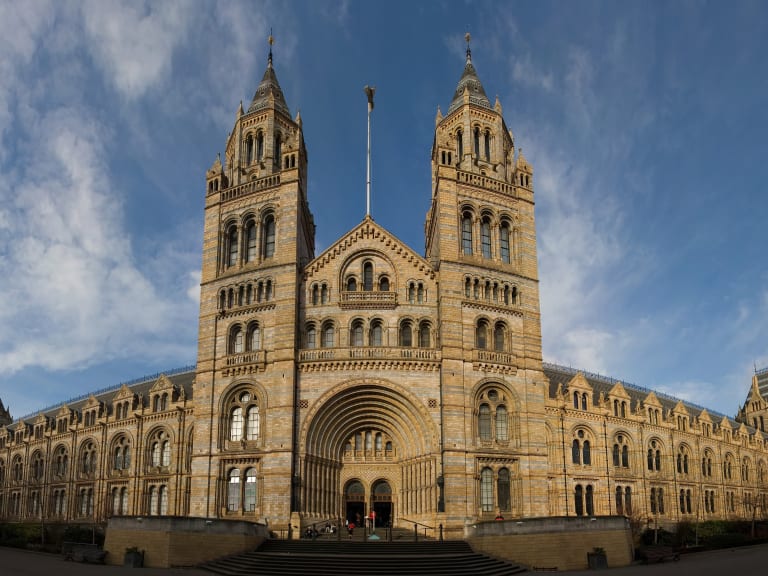
London offers its visitors attractions of all kinds. This variety is what allows the tour for this fourth day to be composed of the most disparate places.
Hyde Park
Day four begins with a relaxing stroll through one of London's finest parks, Hyde Park. Its paths hide attractions such as the statue of Peter Pan, the Speaker's Corner or the Serpentine Lake.
Natural History Museum
The Natural History Museum is one of the most spectacular museums in London, especially if you are traveling with children.
Its collection is composed of millions of elements of nature, but undoubtedly the most striking is the area dedicated to dinosaurs, including the impressive full-scale reconstruction of a T-Rex equipped with movement and sound.
Admission is free and it is full of games and interactive attractions to make the visit a great plan to do with children.
Relax on a boat on the Thames
When you finish enjoying nature in the heart of the big city, you will have to head to the Thames River to enjoy a special activity: a small cruise.
There is a great offer of these river cruises, so here is an article about the best cruises on the Thames so you can choose the one you like the most.
London Dungeon or Sea London Aquarium

In the area of Westminster Bridge you will find a perfect place if you are a fan of terror: the London Dungeon.
It is an interactive attraction that tells the darkest history of the city and ensures that the most fearful are startled on occasion.
In case you go with children (for whom the attraction is not recommended) or are not too fond of gruesome stories, not too far away is the Sea Life London Aquarium.
London Eye
From an attraction designed to scare you to another that can cause sweating to those who suffer from vertigo. This is the London Eye, a spectacular wheel 135 meters high.
To get on it, I recommend you buy tickets for the London Eye in advance so you can enjoy the best views of London.
Don't worry if it has gotten dark in London, as the London Eye is still working to offer a panoramic view of the city's illumination.
When you get off, you may want to look for one of the restaurants around the London Eye for dinner.
Day 5: Visit Stonehenge and Bath in a single day

One of the great advantages of having a whole week in London is that you will be able to afford organized tours from London.
Near London is, for example, Stonehenge, a visit that can be combined with such beautiful cities as Bath. In order to see both places you will have to decide whether to do it on your own or hire an organized tour to Stonehenge.
In case you prefer to rent a car or use public transport, take into account what I explain in my article on How to get to Stonehenge from London. Then, study the pros and cons to see if the organized tour is more convenient for you.
Excursion to Stonehenge and Bath
If you are looking to make the most of your time during your trip, I recommend you to combine in one tour the visit to Stonehenge and the city of Bath.
The charm of Stonehenge increases especially during the summer solstice, a particularly recommended time to visit it.
As for Bath, this city is considered one of the most charming cities in the country both for the baths that make it famous and for many other attractions that you can discover during this visit.
Day 6: Portobello, Covent Garden and the West End

The penultimate day of your trip will start in one of the city's most colorful neighborhoods, Notting Hill, and end with a visit to one of London's many shows.
Notting Hill and Portobello Road
Although it became famous around the world for the movie that bore his name, Notting Hill was already known for its colorful and carnivals held there. This party is, without discussion, one of the best things to do if you are in London in August.
Its best known street is Portobello Road, which crosses the neighborhood almost completely. The best day to make this visit is Saturday, as that day is installed one of the most complete flea markets in the city.
Madame Tussauds
Undoubtedly, the Madame Tussauds museum presents the best wax figures from around the world.
In this museum you will see realistic wax figures of thousands of famous people from around the world, from athletes to great protagonists of history, through actors or scientists.
Covent Garden
In the afternoon is a good time to walk around the area of Covent Garden and catch the special atmosphere that characterizes it. Here there was an old flower market and today you will find numerous street artists, restaurants, pubs and food stalls.
In case you go with children, this square is home to a museum that they usually like quite a lot: the London Transport Museum.
West End
The tour of this day will end in the West End, one of the liveliest areas of the city.
Here you will find many dining options and it is also where most of the theaters in London are located. Precisely, I advise you to end the day watching one of the musicals performed in the West-End.
Day 7: Sherlock Holmes, the War Museum and Primrose Hill
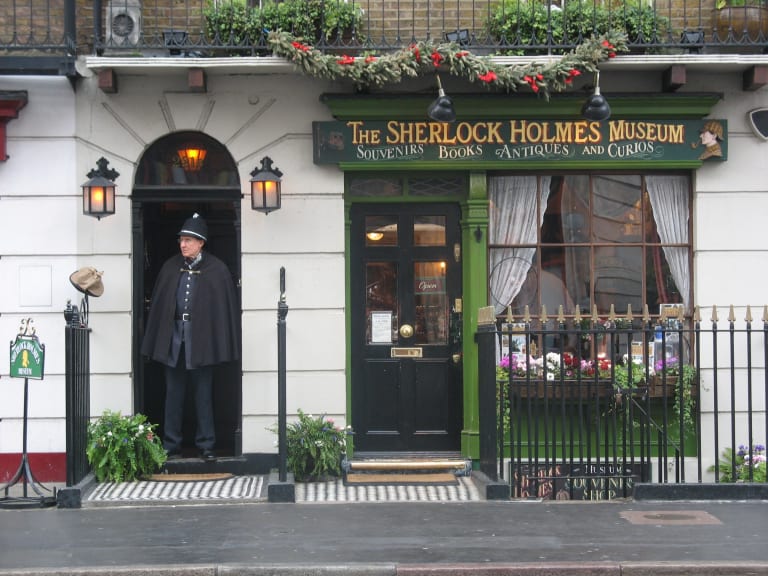
Normally, we all arrive at the last day of a trip quite tired and, moreover, with a strange feeling of sadness at the end of the experience. However, this should not prevent us from enjoying every last moment.
Follow Sherlock Holmes' route through Baker Street
London was also the place where Sir Arthur Conan Doyle set the stories of the most famous private detective in history: Sherlock Holmes.
As could not be less, the city has a museum dedicated to the character, whose location will not surprise any fan: 221B Baker Street, just at the address where Holmes lived in the novels.
Primrose Hill
After leaving Baker Street there is no better place to go than Primrose Hill. This park is located on a hill that gives its visitors a beautiful view of the city.
The atmosphere in the park is very pleasant and it is, without a doubt, an ideal place for you to have a picnic or eat in some of the restaurants in the area.
Imperial War Museum
After a relaxed lunch it is time to visit one of the most interesting and, at the same time, disturbing museums in the city.
It is the Imperial War Museum, which as its name suggests, is dedicated to war. Inaugurated in 1920, its first purpose was to show the consequences of the First World War on society. Over time, its collection was expanded to show objects, documents, weapons and testimonies of victims of other conflicts, such as the Second World War.
Last walk through Piccadilly Circus and Oxford Street
Londoners and tourists alike consider Piccadilly Circus to be **London'**s most famous intersection.
Some consider it to be London's equivalent of New York's Times Square. Seeing it at night before strolling down one of the city's most commercial streets is the perfect end to a trip.
Soak up the atmosphere of Oxford Street
This shopping street is considered the busiest in Europe. Its almost 2 and a half kilometers are full of stores of all kinds, restaurants and other shops that attract a large number of Londoners and visitors.
Walking down this street you will be able to see some of the most famous department stores in the city. Some, like Selfridges, are located in buildings with a high architectural value.
If you have had the immense luck to travel to London at Christmas this street is a must visit for its Christmas lights.


